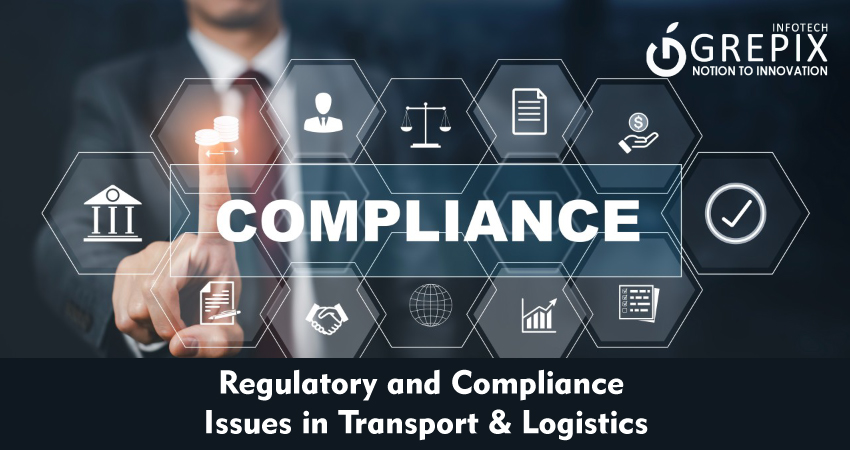Regulatory and Compliance Issues in Transport & Logistics
In the dynamic world of transport and logistics, regulatory compliance is no longer a box to tick; it is a strategic necessity. From shifting global standards to regional updates, logistics compliance regulations shape every stage of the supply chain from procurement to final-mile delivery. The surge of “transport laws logistics” and specialized “regulatory logistics app” solutions has redefined risks and opportunities for both established players and startups. In 2025, compliance is not just about avoiding fines it’s about building trust, fostering efficiency, and sustaining growth.
Regulatory and compliance issues are now at the heart of every successful transport and logistics operation worldwide. With major shifts in logistics compliance regulations, evolving transport laws, and unique logistics startup legal issues entering the market in 2025, businesses must adapt rapidly to survive and scale. This article explains the importance of compliance in logistics, examines global and regional regulations, highlights startup challenges, explores technology and regulatory logistics apps, and provides real-life examples and statistics. Whether launching a logistics startup or expanding across borders, unlock actionable insights and proven solutions to achieve regulatory clarity and outperform competitors.
Why Compliance Matters in Transport & Logistics
Building Trust and Reliability
Logistics compliance regulations underpin the entire value chain in transport. Adhering to “transport laws logistics” safeguards against fines, delays, and damaged reputation, especially with heightened customer demands for secure, ethical, and timely deliveries.
- Compliance helps protect end customers and partners from fraud and subpar standards.
- A robust compliance strategy ensures risk management for cargo, drivers, and data.
Avoiding Costly Penalties and Disruptions
Global audits show that over 85% of supply chain firms faced business losses due to non-compliance in 2024–2025, with penalties ranging from $20,000 to $20 million, depending on the regulatory breach.
- Real-life example: A major logistics company in Thailand paid $20 million in fines after violating international sanctions in 2024.
- Non-compliance can result in delayed shipments, goods held in customs, or suspension of business licenses.
Navigating Cross-Border Operations
With increasingly complex logistics compliance regulations, cross-border transport demands increased attention to customs, sustainability, and data privacy.
- Regional differences can trigger unexpected legal risks without proper compliance protocols.
- Accurate paperwork and real-time data sharing are now mandatory in major markets.
Regional and Global Logistics Compliance Regulations
United States
The U.S. has introduced new logistics compliance regulations, including a 10-year recordkeeping requirement for exporters and stricter oversight by the Bureau of Industry and Security (BIS) and the Office of Foreign Assets Control (OFAC).
- Example: Exporters must update procedures overnight as new entities are added to trade watchlists.
- Logistics startups must integrate compliance monitoring into all digital platforms.
European Union
The EU’s transition to mandatory full reporting under the Carbon Border Adjustment Mechanism (CBAM) and Environmental, Social, and Governance (ESG) standards from January 2025 means companies must report all carbon-intensive imports with high accuracy.
- New customs regulations require end-to-end traceability for sustainability reporting.
- Firms failing ESG compliance risk exclusion from tenders and higher penalties.
Asia-Pacific
India’s National Logistics Policy (NLP 2022) aims to reduce logistics costs from 13% to 8% of GDP by 2030, with stringent licensing requirements, multimodal compliance rules, and unified digital documentation.
- Startups must obtain multiple permits and comply with stringent SLAs to avoid legal pitfalls.
- Data protection and insurance regulations are rising in priority for logistics compliance.
Global Standards
International bodies, including the OECD, ITF, and United Nations Economic Commission for Europe, support harmonizing transport laws and compliance regulations across borders.
- Best practices include applying global data privacy, safety, and digital security measures in every region.
- Harmonized reporting frameworks encourage smoother cross-border logistics operations.
Impact on Logistics Startups
Common Legal Issues for Logistics Startups
Launching a logistics business today means confronting a vast array of “logistics startup legal issues,” from unclear Service Level Agreements to complex liability and insurance matters.
Top Startup Legal Challenges:
- Vague or unenforceable SLAs:leading to disputes over delivery times and shipment condition.
- Liability for cargo damage or loss:especially where multiple contractors are involved.
- Permit and licensing complexity:navigating bureaucratic hurdles for interstate and international shipments.
- Environmental and safety compliance:risk of fines for breaches in handling hazardous or carbon-heavy goods.
- Data security:legal exposure due to information breaches, especially with app-connected shipments.
Case Study: Startup Expansion Gone Wrong
A budding logistics startup signed contracts with broad delivery terms. When a major consignment was delayed, the ambiguity led to lost reputation and legal wrangling. Clear SLAs and a focus on transport laws logistics could have avoided major financial and reputational losses.
Tips for Startups
- Draft clear, measurable SLAs, outlining precise delivery windows and penalties for late delivery.
- Ensure contracts specify insurance provisions and liability at every step shipping, warehousing, delivery.
- Keep regulatory documents updated and invest in ongoing compliance training.
Technology Solutions: Regulatory Logistics Apps
The Rise of Regulatory Logistics Apps
Modern transport relies on digital platforms that embed regulatory checkpoints directly into workflows. Today’s “regulatory logistics app” solutions are helping logistics firms automate and comply with complex regulations in real time.
Key Features in 2025 Regulatory Apps:
- Route optimization algorithms for fuel efficiency and adherence to city or country rules.
- Real-time driver monitoring ensuring compliance with safety, speed, and work-hour restrictions.
- Automated updates for customs form changes and regulatory shifts in core markets.
- Document management and e-signature capabilities for instant compliance proof.
Practical Use Cases
- E-commerce apps: Real-time shipment tracking, customer notification, and automated compliance alerts for hazardous goods.
- Healthcare logistics: Temperature and safety monitoring, seamless reporting for regulatory audits.
- Freight and 3PL: Deep integration with partner systems, contract management, and digital insurance claims.
Why Tech Is Essential
Automated regulatory logistics apps prevent human error, reduce costs, and provide instant compliance documentation during audits or border checks. Integration with accounting tools also eases tax reporting and payroll compliance, key for logistics startups seeking rapid scale.
Global Statistics and Industry Trends
India’s logistics industry is valued at over $228.4 billion, expected to grow to $357.3 billion by 2030; regulatory reforms are credited for this 7.7% CAGR growth.
- 85% of global logistics firms experienced business losses due to non-compliance between 2024–2025.
- The frequency of regulatory changes is escalating, with new EU, U.S., and APAC standards rolling out quarterly and affecting carbon reporting, safety, and data management.
- Technology and automation are cited as the top investments (78%) by logistics firms aiming to meet compliance demands in 2025.
Conclusion
Regulatory and compliance issues in transport and logistics are not static they are a moving target shaped by global trends, local pressures, and technological evolution. From logistics compliance regulations and transport laws logistics, to startup legal issues and regulatory logistics app solutions, every stakeholder must embrace compliance as a competitive edge.
In 2025, surviving and thriving in transport means leveraging digital solutions, updating contracts, and fostering a culture of ongoing education around rules. Whether launching a logistics startup or managing global freight, the right compliance approach delivers operational excellence, trust, and bottom-line results.
FAQs
1. What are the most critical logistics compliance regulations in 2025?
Major regulations include CBAM (EU), stringent recordkeeping laws (US), environmental standards, and digital customs reporting requirements.
2. How do transport laws logistics differ by region?
Transport laws logistics vary due to environmental, customs, safety, and data protection rules; regional differences can create legal hurdles for companies operating internationally.
3. What legal issues should logistics startups watch out for?
Startups should watch for unclear SLAs, liability clauses, licensing complexities, data security requirements, and environmental standards.
4. What features should regulatory logistics apps include?
Apps should offer route optimization, real-time compliance alerts, document management, digital insurance processing, and automated updates for new regulations.
5. How often do logistics compliance regulations change?
Regulations now change quarterly or even monthly in key markets, requiring continuous monitoring and real-time adaptation.







